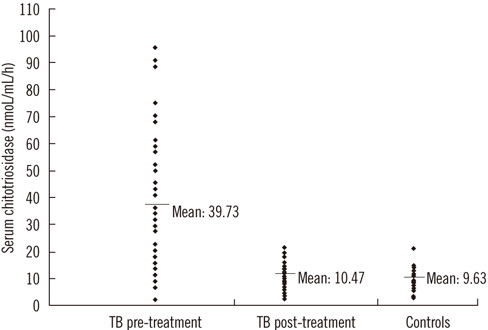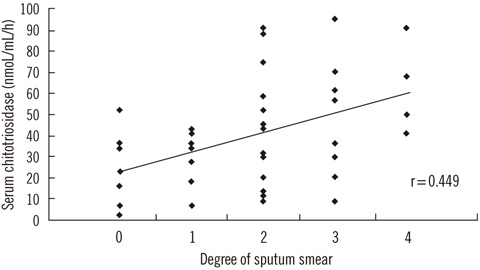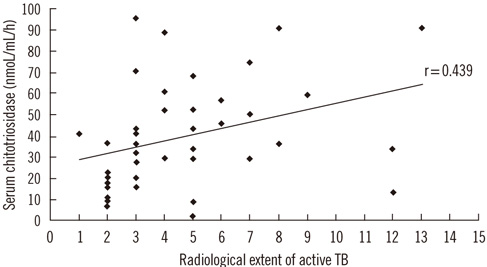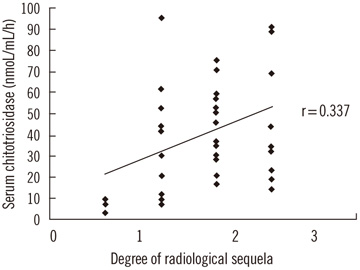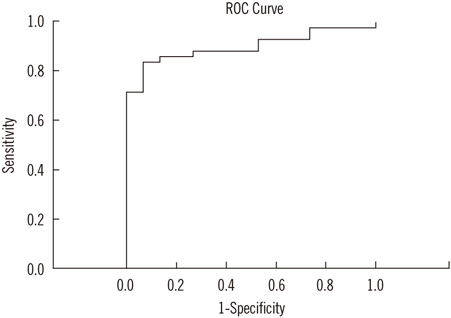Ann Lab Med.
2012 May;32(3):184-189. 10.3343/alm.2012.32.3.184.
Serum Chitotriosidase Activity in Pulmonary Tuberculosis: Response to Treatment and Correlations with Clinical Parameters
- Affiliations
-
- 1Department of Pulmonary Medicine, Gulhane Military Medical Academy Haydarpasa Training Hospital, Istanbul, Turkey.
- 2Department of Pulmonary Medicine, Gulhane Military Medical Academy, Ankara, Turkey. eyfettingumus@gmail.com
- 3Department of Pulmonary Medicine, TAF Rehabilitation Center, Gulhane Military Medical Academy, Ankara, Turkey.
- 4Department of Biochemistry, Gulhane Military Medical Academy, Ankara, Turkey.
- 5Department of Radiology, Gulhane Military Medical Academy, Ankara, Turkey.
- KMID: 1381682
- DOI: http://doi.org/10.3343/alm.2012.32.3.184
Abstract
- BACKGROUND
Chitotriosidase is an accepted marker of macrophage activation. In this study, we investigated serum chitotriosidase levels in pulmonary tuberculosis (PTB).
METHODS
Forth-two patients with PTB and 30 healthy subjects were enrolled in the study. The radiological extent of PTB, radiological sequela after treatment, and the degree of smear positivity were assessed. Chitotriosidase levels were measured by a fluorometric method.
RESULTS
The serum chitotriosidase levels of the PTB patients were significantly higher than those of the control subjects (39.73+/-24.97 vs. 9.63+/-4.55 nmol/mL/h, P<0.001). After completion of the standard 6-month antituberculous treatment, chitotriosidase levels in PTB patients significantly decreased (10.47+/-4.54 nmol/mL/h, P<0.001). Chitotriosidase levels correlated significantly with the radiological extent of PTB, degree of smear positivity, and post-treatment radiological sequela score (r=0.439, r=0.449, and r=0.337, respectively).
CONCLUSIONS
This study demonstrated that serum chitotriosidase levels increase in PTB; therefore, chitotriosidase can be used as a marker of disease activity, severity, and response to treatment.
Keyword
MeSH Terms
Figure
Reference
-
1. Di Rosa M, Musumeci M, Scuto A, Musumeci S, Malaguarnera L. Effect of interferon-γ, interleukin-10, lipopolysaccharide and tumor necrosis factor-α on chitotriosidase synthesis in human macrophages. Clin Chem Lab Med. 2005. 43:499–502.
Article2. Malaguarnera L. Chitotriosidase: the yin and yang. Cell Mol Life Sci. 2006. 63:3018–3029.
Article3. Hollak CE, van Weely S, van Oers MH, Aerts JM. Marked elevation of plasma chitotriosidase activity. A novel hallmark of Gaucher disease. J Clin Invest. 1994. 93:1288–1292.
Article4. Michelakakis H, Dimitriou E, Labadaridis I. The expanding spectrum of disorders with elevated plasma chitotriosidase activity: an update. J Inherit Metab Dis. 2004. 27:705–706.5. Bargagli E, Maggiorelli C, Rottoli P. Human chitotriosidase: a potential new marker of sarcoidosis severity. Respiration. 2008. 76:234–238.
Article6. Artieda M, Cenarro A, Gañán A, Jericó I, Gonzalvo C, Casado JM, et al. Serum chitotriosidase activity is increased in subjects with atherosclerosis disease. Arterioscler Thromb Vasc Biol. 2003. 23:1645–1652.
Article7. Malaguarnera L, Rosa MD, Zambito AM, dell'Ombra N, Marco RD, Malaguarnera M. Potential role of chitotriosidase gene in nonalcoholic fatty liver disease evolution. Am J Gastroenterol. 2006. 101:2060–2069.
Article8. Altarescu G, Rudensky B, Abrahamov A, Goldfarb A, Rund D, Zimran A, et al. Plasma chitotriosidase activity in patients with beta-thalassemia. Am J Hematol. 2002. 71:7–10.9. Comabella M, Domínguez C, Rio J, Martín-Gallán P, Vilches A, Vilarrasa N, et al. Plasma chitotriosidase activity in multiple sclerosis. Clin Immunol. 2009. 131:216–222.
Article10. Grosso S, Margollicci MA, Bargagli E, Buccoliero R, Perrone A, Galimberti D, et al. Serum levels of chitotriosidase as a marker of disease activity and clinical stage in sarcoidosis. Scand J Clin Lab Invest. 2004. 64:57–62.
Article11. Bargagli E, Margollicci M, Nikiforakis N, Luddi A, Perrone A, Grosso S, et al. Chitotriosidase activity in the serum of patients with sarcoidosis and pulmonary tuberculosis. Respiration. 2007. 74:548–552.
Article12. Bargagli E, Margollicci M, Luddi A, Nikiforakis N, Perari MG, Grosso S, et al. Chitotriosidase activity in patients with interstitial lung diseases. Respir Med. 2007. 101:2176–2181.
Article13. Gray JW. Childhood tuberculosis and its early diagnosis. Clin Biochem. 2004. 37:450–455.
Article14. Segura RM, Pascual C, Ocaña I, Martínez-Vázquez JM, Ribera E, Ruiz I, et al. Adenosine deaminase in body fluids: a useful diagnostic tool in tuberculosis. Clin Biochem. 1989. 22:141–148.
Article15. Deniz O, Gumus S, Yaman Y, Ciftci F, Ors F, Cakir E, et al. Serum total cholesterol, HDL-C and LDL-C concentrations significantly correlate with the radiological extent of disease and the degree of smear positivity in patients with pulmonary tuberculosis. Clin Biochem. 2007. 40:162–166.
Article16. Bouzas L, San José E, Tutor JC. Chitotriosidase activity in pleural effusions. Clin Lab. 2007. 53:449–452.17. Seaton A, Seaton D, editors. Crofton and Douglas's Respiratory Diseases. 1989. 4th ed. London: Blackwell Science.18. Deniz O, Gumus S, Yaman H, Ciftci F, Ors F, Cakir E, et al. Serum total cholesterol, HDL-C and LDL-C concentrations significantly correlate with the radiological extent of disease and the degree of smear positivity in patients with pulmonary tuberculosis. Clin Biochem. 2007. 40:162–166.
Article19. Poggi A, Catellani S, Musso A, Zocchi MR. Gammadelta T lymphocytes producing IFNgamma and IL-17 in response to Candida albicans or mycobacterial antigens: possible implications for acute and chronic inflammation. Curr Med Chem. 2009. 16:4743–4749.20. van Eijk M, van Roomen CP, Renkema GH, Bussink AP, Andrews L, Blommaart EF, et al. Characterization of human phagocyte-derived chitotriosidase, a component of innate immunity. Int Immunol. 2005. 17:1505–1512.
Article21. Labadaridis I, Dimitriou E, Theodorakis M, Kafalidis G, Velegraki A, Michelakakis H. Chitotriosidase in neonates with fungal and bacterial infections. Arch Dis Child Fetal Neonatal Ed. 2005. 90:F531–F532.
Article22. Lehrnbecher T, Bernig T, Hanisch M, Koehl U, Behl M, Reinhardt D, et al. Common genetic variants in the interleukin-6 and chitotriosidase genes are associated with the risk for serious infection in children undergoing therapy for acute myeloid leukemia. Leukemia. 2005. 19:1745–1750.
Article23. Choi EH, Zimmerman PA, Foster CB, Zhu S, Kumaraswami V, Nutman TB, et al. Genetic polymorphisms in molecules of innate immunity and susceptibility to infection with Wuchereria bancrofti in South India. Genes Immun. 2001. 2:248–253.
Article24. Malaguarnera L, Musumeci M, Di Rosa M, Scuto A, Musumeci S. Interferon-gamma, tumor necrosis factor-alpha, and lipopolysaccharide promote chitotriosidase gene expression in human macrophages. J Clin Lab Anal. 2005. 19:128–132.
Article25. Kurt YG, Cayci T, Onguru P, Akgul EO, Yaman H, Aydin I, et al. Serum chitotriosidase enzyme activity in patients with Crimean-Congo hemorrhagic fever. Clin Chem Lab Med. 2009. 47:1543–1547.
Article26. Iyer A, van Eijk M, Silva E, Hatta M, Faber W, Aerts JM, et al. Increased chitotriosidase activity in serum of leprosy patients: association with bacillary leprosy. Clin Immunol. 2009. 131:501–509.
Article27. Tercelj M, Salobir B, Simcic S, Wraber B, Zupancic M, Rylander R. Chitotriosidase activity in sarcoidosis and some other pulmonary diseases. Scand J Clin Lab Invest. 2009. 69:575–578.
- Full Text Links
- Actions
-
Cited
- CITED
-
- Close
- Share
- Similar articles
-
- A Study on Angiotensin Converting Enzyne Activity in Pulmonary Tuberculosis
- The Activities of Leucocytic Acid Phosphatase in Pulmonary Tuberculosis
- Hematological Study on Pulmonary Tuberculosis Patients
- Assessing Pulmonary Tuberculosis Using Bandim Tuberculosis and Karnofsky Performance Scale Scores with Serum Adenosine Deaminase Levels
- sICAM-1, sE-selectin, sVCAM-1 Concentration in Patients with Pulmonary Tuberculosis

